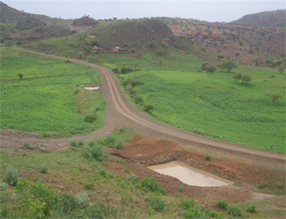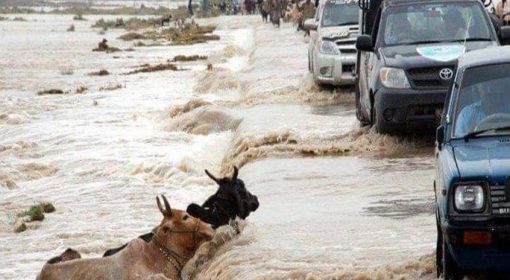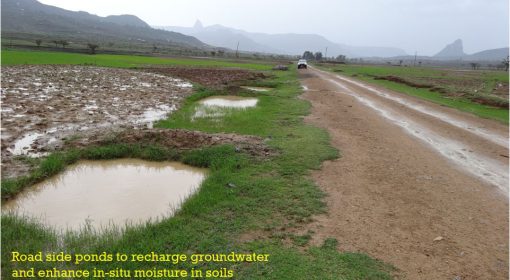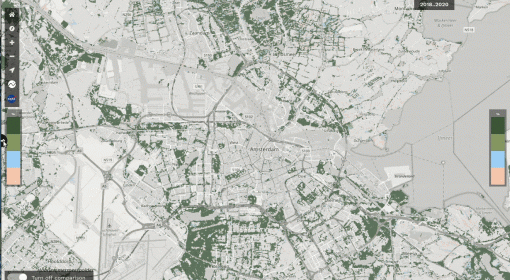by Miltiadis Vitsas (MetaMeta Research)

Roads and insects
Roads serve as vital infrastructural arteries that facilitate regional development and enhance the quality of life for human populations. They provide efficient connectivity and support economic growth (Munoz et al., 2014). However, the construction and expansion of roads can have significant environmental consequences, such as habitat fragmentation and alteration of natural ecosystems.
While discussion earlier often focused on the impacts of roads on larger animals, there is a growing recognition of the need to consider the effects on smaller organisms, particularly insects. Insects are of paramount importance as they represent more than 80% of the species on earth, which makes them the most diverse group of organisms on Earth, playing crucial roles in ecological processes, such as pollination, decomposition, and nutrient cycling (Munoz et al., 2014). Unfortunately, insect population are often decimated on the roads. Understanding the interactions between roads and insects is therefore essential for comprehending the broader ecological implications of road construction and implementing effective mitigation measures. By examining the relationship between roads and insects, we can gain valuable insights into the conservation of biodiversity and the sustainable development of transportation infrastructure.
Several studies highlight the significant impact of roads on insect populations. Gepp’s (1973) study estimated the insect mortality in Germany due to collisions with vehicles at a range of 100-3000 individuals per vehicle per kilometer, leading to the loss of trillions of individuals. As an example, a local population of the threatened rattle grasshopper adjacent to a road in Germany suffered losses of 30% of the local population due to road mortality (Van Der Ree et al. 2015). Also at least 6.8% of the butterflies were estimated to end up on the road killed (Munoz et al., 2014). While many butterflies attempt to avoid crossing roads, those individuals that do cross often experience high rates of mortality. In some cases, one out of three individuals attempting to cross a road will be killed (Pfister et al., 1997). Furthermore, research conducted in Switzerland found up to dead 2000 moths per kilometer along roads, while in Illinois, United States, an average of 2-35 dragonflies were killed per kilometer per day (Van Der Ree et al. 2015). These findings highlight the alarming impact of roads on insect populations. The loss of such a vast number of insects can disrupt ecological processes and have cascading effects on ecosystems. It is crucial to consider these consequences when planning and designing transportation infrastructure. Implementing measures to mitigate the impacts of roads on insects, such as creating corridors, installing wildlife-friendly fencing, and incorporating ecological considerations into road planning. This can help reduce mortality rates and minimize the ecological disruption caused by roads. By integrating this understanding of the relationship between roads and insects, we can gain valuable insights into the conservation of biodiversity and the sustainable development of transportation infrastructure.
Insect road kills and disruptions
The impacts of roads on insect populations are intricate, influenced by several factors that include road width, traffic volume, vehicle speed, time of day or year, and the habitat diversity along the road corridor (Gaudel et al., 2019). These factors collectively contribute to a range of detrimental effects on insect communities. One of the primary consequences of roads is their barrier effect on insect movements. As insects navigate their environments, roads can present formidable obstacles, impeding their ability to disperse and find suitable habitats (Anderson et al., 2017). This barrier effect can fragment populations, isolating them in smaller patches of habitat and hindering gene flow between populations. The inability to migrate and mix genetic diversity can have long-term consequences for the adaptability and survival of insect species. Furthermore, roads often result in the loss of insect biodiversity and abundance. The disturbance caused by road construction and subsequent vehicle traffic can disrupt insect populations, leading to a decline in species richness and population sizes (Ferreira et al., 2021). Insect populations near roads may suffer from increased mortality due to vehicle collisions, as well as from indirect effects such as pollution, noise, and light pollution, which can disrupt their behaviors and life cycles.
Habitat fragmentation is another significant impact of roads on insect populations. As roads cut through natural landscapes, they divide continuous habitats into smaller, fragmented patches. This fragmentation restricts insect movements, limits access to resources, and reduces the overall quality of available habitats. These fragmented habitats are often unable to support diverse and viable insect populations, leading to a decline in species richness and ecological functioning (Gaudel et al., 2019). Mitigating the impacts of roads on insect populations requires considering various strategies.
What to do?
Insects play a vital role in ecosystems, and it is essential to consider their conservation when planning and constructing roads. Here are some recommendations for minimizing the negative impacts of roads on insect populations:
- Protect and enhance road verges: Road verges can serve as crucial habitats for insects, providing additional refuge and food sources. It is essential to recognize the value of these areas and implement measures to protect and manage them effectively. By preserving and enhancing road verges, we can provide diverse vegetation, including native wildflowers, shrubs, and grasses, which offer valuable resources for a variety of insect species. This approach contributes to maintaining healthy insect populations and promotes ecological balance (Ferreira et al., 2021).

- Incorporate wildlife crossings, underpasses and overpasses: To mitigate the barrier effect of roads on insect movements, it is crucial to incorporate wildlife crossings and overpasses into road infrastructure projects. These structures allow insects and other wildlife to safely cross the road, maintaining connectivity between habitats and reducing the risk of population fragmentation. When designing these crossings, it is important to consider insect-specific need (Bond et al., 2008).

- Creating vegetation corridors along the crossings can attract pollinators, while providing suitable microhabitats within underpasses can support ground-dwelling insects.
- Practice sustainable road construction: Careful planning and design should consider insect-friendly practices during road construction. This includes minimizing habitat destruction and preserving existing insect habitats whenever possible. By incorporating green infrastructure elements, such as retaining natural vegetation, planting native species, and implementing proper drainage systems, we can create road environments that are more compatible with insect populations. Sustainable road construction practices contribute to maintaining ecological balance and preserving insect diversity.
- The butterfly effect: Scientists discovered that butterflies would only cross the roadway during traffic jams when the air was still. Butterfly web are designed to connect from one side of the road to the other so that it would block the fast-moving air created by passing vehicles (Optimist daily., 2021).
- Conduct monitoring and research: Continual monitoring and research are crucial for understanding the impacts of roads on insects and evaluating the effectiveness of mitigation measures. By collecting data on insect populations, species composition, and behavior near roads, we can gain valuable insights into their responses to road infrastructure. This information can inform adaptive management strategies and help improve future road design and mitigation efforts to better protect insect populations. By implementing these recommendations, we can mitigate the negative impacts of roads on insect populations while simultaneously supporting their important ecological roles. Taking proactive measures to protect insects during road planning, construction, and management is essential for conserving biodiversity, maintaining ecosystem functioning, and promoting sustainable development.
Summing up
In conclusion, roads have significant effects on insect populations, with implications for biodiversity and ecosystem functioning. The construction and presence of roads can result in habitat fragmentation, as they divide natural landscapes into smaller patches, limiting insect movements and impeding gene flow. Additionally, insects face mortality risks from vehicle collisions, which can impact population sizes and species richness. Furthermore, roads can act as barriers to dispersal, isolating insect populations and hindering their ability to access suitable habitats. To effectively conserve insects and mitigate the negative impacts of roads, it is essential to understand the specific effects and interactions between roads and insect populations. Further research and monitoring efforts are needed to assess the extent of road impacts, identify vulnerable species or groups, and evaluate the success of mitigation measures. By gaining a comprehensive understanding of the relationships between roads and insects, we can develop targeted conservation strategies that safeguard insect abundance and diversity. Mitigation measures should be implemented during road construction and management to minimize negative effects on insects. Incorporating wildlife crossings and underpasses into road designs can facilitate safe movement across roads, reducing mortality risks and enhancing connectivity between habitats. Protecting and enhancing road verges can provide additional habitat and food sources for insects. Sustainable road construction practices, such as preserving existing insect habitats and implementing green infrastructure elements, contribute to maintaining ecological balance and reducing impacts on insect populations. In conclusion, recognizing the importance of insects and their ecological roles is paramount when planning and managing road infrastructure. By integrating insect conservation considerations into road development, we can promote coexistence between transportation networks and thriving insect communities, ensuring the preservation of biodiversity and the essential ecological services provided by these remarkable organisms.
References
Andersson P., Koffman A., Sjodin E.N., Johansson V., (2017), Roads may act as barriers to flying insects: species composition of bees and wasps differs on two sides of a large highway
Bond A., Darryl N.J., (2008). Temporal trends in use of fauna-friendly underpasses and overpasses
Ferreira D.J., Berggeren A., Wissman J., Ockinger E., (2021), Road verges are corridors and roads barriers for the movement of flower-visiting insects
Gaudel P., Paudel M., Gaudel P., Girl B.R., Shretsha B.R., (2019), Mortality Census of the Road-Killed Butterflies in Mahendra Highway, Nepal. Journal of insect biodiversity and systematics
Gepp, J. 1973. Kraftfahrzeugverkehr und fliegende Insekten [Car traffic and winged insects]. Natur und Landschaft 59: 127–129.
Munoz P.T., Torres F. P., Megias A. G., (2014), Effects of roads on insects: a review. Article in Biodiversity and Conservation
Van Der Ree, R., Smith, D. J., & Grilo, C. (2015). Handbook of Road Ecology. In Wiley eBooks. https://doi.org/10.1002/9781118568170



